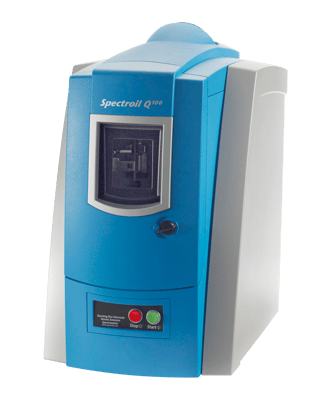Introduction
Synthetic Polyol Ester fluids are the fluids of choice to lubricate aircraft gas turbine engines used in commercial and military service requiring MIL-PRF-23699F-STD level performance. It also is used for aircraft-type gas turbine engines in industrial or marine service applications.

These synthetic lubricants are formulated to meet the demanding requirements of aircraft gas turbines operating over a wide range of severe operating conditions. They have
excellent thermal and oxidation stability to reduce sludge and varnish deposits and they
have a high specific heat. The lubricants also retain viscosity and film strength over a wide
temperature range (-40°C to 204° C or -40°F to 400°F).
When testing these fluids on a Spectroil calibrated with mineral based oil standards,
there may be matrix effects present from the sample which are not accounted for in the
commercially available mineral oil wear metal standards. Even though the trending
capability of the calibration is maintained, a significant difference in the sample matrix
can affect the accuracy of the result. For applications where accuracy is very important or
the matrix effect is severe, a custom calibration program can be created by the user using
custom or matrix-specific elemental standards.
Background
Test standards (c0, c5, c10, and c20 of 0, 5, 10, and 20 ppm metal elements) and unknown
samples of an in-service synthetic gas turbine lubricant were analyzed on the Spectroil for
wear metals. The synthetic oil type was MIL-PRF-23699F, NATO code o-156/o-152 which
is a polyol ester based fluid. The test standards and samples were run using the factory
Spectroil M/N program for compliance to the JOAP program using the mineral oil based
D19 and D12 standards. The instrument provided accurate results for the JOAP mineral oil
based standards D19-0 ppm, D12-5 ppm, and D12-10 ppm but did not provide satisfactory
results for the synthetic test standards.
The test standards reported significantly higher than their known elemental concentration. It was concluded that the poor accuracy was a result of the difference in matrix between the synthetic turbine oil compared to the mineral-based hydrocarbon JOAP standards. For improved accuracy, a new calibration can be created.
Method
A calibration could be created with the supplied test standards, but for a more robust analysis an independent set of calibration standards was prepared with the same matrix oil. A set of synthetic turbine oil standards (SYNGT-0 ppm, SYNGT-50 ppm, etc) was prepared by careful dilution of a D19-900 ppm oil standard into synthetic oil base o-156/o-152 at concentrations of 0, 5, 10, 20, 30, 50, and 100 ppm.
A new calibration program SYNGT was created by copying the existing M/N program on the Spectroil. The Standardization Sample Names SYNGT-0, SYNGT-5, SYNGT-10, SYNGT-20,
SYNGT-30, SYNGT-50, and SYNGT-100 were added at the end of the list under System >> Standardization Samples.
The calibration procedure was then performed with the prepared standards according to the standard operating instructions in the manual for daily operation.
1. Three warm up burns
2. Profile
3. Disc offset procedure
4. 5 burns of 0 ppm (o-156/o-152 oil) in order to set the reference values
5. 5 burns of each prepared standard: 0 ppm, 5 ppm, 10 ppm, 20 ppm, 30 ppm, 50 ppm, 100 ppm.
The results for five burns of each prepared standard were examined in Intensity Ratio mode and then recorded. These values were entered as the calibration curves and the expected standardization values in the channel configuration screen in the SYNGT program for each element in the list (Figure 3). The fields with D-19 standards were replaced with the appropriate SYNGT standards. All other fields were left the same as the template M/N program. The channel configuration changes were saved by clicking ok.
Results
After the SYNGT program was set up and calibrated, the daily standardization routine was performed and the standardization was checked with four burns of the SYNGT standards. The check burns made with the SYNGT standards were within the acceptable limits.
The synthetic turbine oil test standards provided (c0, c5, c10, c20) were then analyzed using the SYNGT program. The test standards were within an acceptable range of the known value (0, 5, 10, 20 ppm) using the new SYNGT program. Unknown turbine samples could now be analyzed with confidence in the accuracy of the result.
Conclusion
When performing elemental analysis on the Spectroil it is generally sufficient to use the appropriate factory-supplied program and elemental standards. However, for specific applications or when accuracy is especially important over trending, it may be necessary to create a new calibration program with matrix-specific elemental standards. A custom calibration program can easily be created by using an existing factory-supplied program as a template. The new calibration program can then be used to analyze samples with improved accuracy.
For more information about creating a custom calibration on the Spectroil, please contact support@spectrosci.com.
Download complete applications note.

